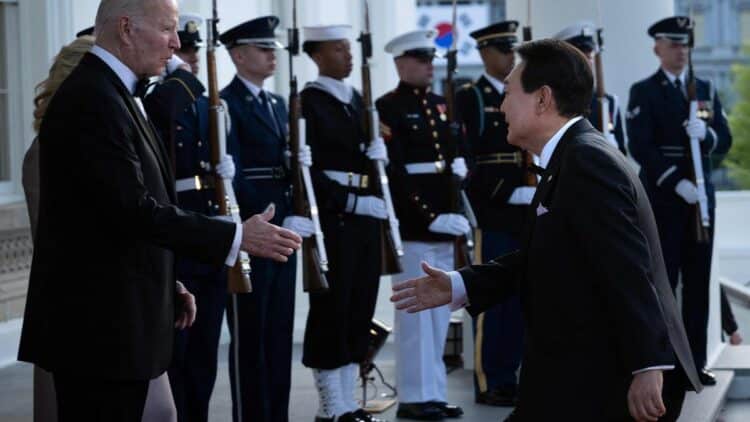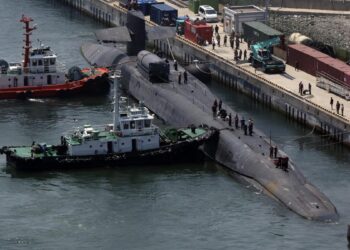
U.S. President Joe Biden greets South Korea’s President Yoon Suk Yeol before a State Dinner at the White House in Washington, DC, on April 26.
| Photo Credit: AFP
The story so far: On April 25, South Korean President Yoon Suk Yeol arrived in the U.S. to commemorate the 70th anniversary of U.S.-South Korea bilateral relations. A highlight of the visit was the signing of the “Washington Declaration” as a nuclear deterrence strategy.
What prompted the U.S. visit?
The successful launch of North Korea’s Hwasong-8 solid-fuel intercontinental ballistic missile (ICBM), a vital component for nuclear weapons delivery, seems to have triggered the U.S. visit of the South Korean President. Mr.Yoon aimed to advance the strategic partnership, drawing an alliance over an extended nuclear deterrence plan against the regional aggression of North Korea. The Washington agreement will launch a new phase in the partnership between Seoul and Washington. “Our two countries have agreed to immediate bilateral presidential consultations in the event of North Korea’s nuclear attack and promised to respond swiftly, overwhelmingly and decisively using the full force of the alliance, including the United States’ nuclear weapons,” said Mr.Yoon.
What does the Washington Declaration say?
The agreement outlines cooperation towards deterrence.
According to the declaration, an American nuclear ballistic submarine would be deployed in the Korean peninsula; a nuclear consultative group would be formed to formulate principles of joint response tactics; South Korea would receive Intel from the U.S. regarding nuclear advancements; and the U.S. will strengthen South Korea’s nuclear deterrence capabilities through joint military training programs and an annual intergovernmental simulation. The declaration reaffirmed the non-proliferation Treaty implying that South Korea would not venture into the creation of its own independent nuclear capabilities and would instead focus on deterrence measures through an alliance-based approach. It also mandates the U.S. President as the only ‘sole authority’ to use the nuclear arsenal of the U.S. in the event of a nuclear confrontation. While the existence of the agreement is based on the security needs of South Korea, the policy reflects big power politics where the interests of the larger power (U.S.) takes precedence.
Why is the U.S. not keen on South Korea having a nuclear arsenal?
South Korea’s nuclear development programme supported by former president Park Chung Hee was hindered due to U.S. pressure. In the 1990s, the U.S. withdrew one hundred nuclear weapons from South Korea as part of their “Strategic Arms Reduction Treaty”. The U.S. was hoping to make North Korea unarm itself. Washington made an erroneous assumption that it could deter the weapons production of North Korea by extracting South Korea’s nuclear capacity.
Secondly, the Nuclear Posture Review 2022 reflects a shift in the U.S. narrative where it is now concerned about the progressing nuclear capacities of North Korea. The report states that North Korea creates “deterrence dilemmas for the United States and its Allies and partners,” and that “a crisis or conflict on the Korean Peninsula could involve a number of nuclear-armed actors, raising the risk of broader conflict.”
And finally, the U.S. wants to control global nuclear arms production. It has been reluctant to allow South Korea to develop their own nuclear arsenal as it would hinder the prolonged efforts of controlling nuclear production in the world. The assurance that the U.S. and its nuclear weapons would protect its allies by being responsible for maintaining stability in the region aligns with the larger goal of non-proliferation. Washington plays a major influence in South Korea’s foreign policy objectives, and Seoul would rather not disappoint the U.S. as they are a vital supporter of their cause.
What has been the regional response?
The Washington Declaration advocates for nuclear deterrence policy in the region, aiming to balance power dynamics against North Korea. While the aim is to defuse the threat, physical deployment of the arsenal can be deemed as a direct threat by opposing actors and used as leverage to act aggressively.
China criticised the agreement with Foreign Ministry spokeswoman Mao Ning saying, “What the U.S. is doing .. provokes confrontation between camps, undermines the nuclear non-proliferation regime and the strategic interests of other countries.” North Korean leader Kim Jong-Un’s sister Kim Yo-jong warned that the declaration would, “only result in making peace and security of North-East Asia and the world be exposed to more serious danger.”
What is the domestic response?
The South Korean public are sceptic about U.S. support. A poll by the Chicago Council on Foreign Relations reported that 71% of South Koreans want to build their own nuclear weapons. With an aggressive North Korea in the neighbourhood, they would prefer their own deterrence.
The writer is a Research Assistant at the National Institute of Advanced Studies (NIAS), Bengaluru
















